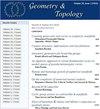Braid monodromy of univariate fewnomials
IF 2.2
1区 数学
引用次数: 3
Abstract
Let $\mathcal{C}_d\subset \mathbb{C}^{d+1}$ be the space of non-singular, univariate polynomials of degree $d$. The Vi\`{e}te map $\mathscr{V} : \mathcal{C}_d \rightarrow Sym_d(\mathbb{C})$ sends a polynomial to its unordered set of roots. It is a classical fact that the induced map $\mathscr{V}_*$ at the level of fundamental groups realises an isomorphism between $\pi_1(\mathcal{C}_d)$ and the Artin braid group $B_d$. For fewnomials, or equivalently for the intersection $\mathcal{C}$ of $\mathcal{C}_d$ with a collection of coordinate hyperplanes in $\mathbb{C}^{d+1}$, the image of the map $\mathscr{V} _* : \pi_1(\mathcal{C}) \rightarrow B_d$ is not known in general. In the present paper, we show that the map $\mathscr{V} _*$ is surjective provided that the support of the corresponding polynomials spans $\mathbb{Z}$ as an affine lattice. If the support spans a strict sublattice of index $b$, we show that the image of $\mathscr{V} _*$ is the expected wreath product of $\mathbb{Z}/b\mathbb{Z}$ with $B_{d/b}$. From these results, we derive an application to the computation of the braid monodromy for collections of univariate polynomials depending on a common set of parameters.单变量少项的辫状单项
设$\mathcal{C}_d\subset \mathbb{C}^{d+1}$为次为$d$的非奇异单变量多项式的空间。vi映射$\mathscr{V} : \mathcal{C}_d \rightarrow Sym_d(\mathbb{C})$向它的无序根集发送一个多项式。这是一个经典的事实,诱导图$\mathscr{V}_*$在基本群的水平上实现了$\pi_1(\mathcal{C}_d)$与Artin辫群$B_d$之间的同构。对于一些多项式,或者等价地对于$\mathcal{C}_d$与$\mathbb{C}^{d+1}$中的坐标超平面集合的相交$\mathcal{C}$,地图$\mathscr{V} _* : \pi_1(\mathcal{C}) \rightarrow B_d$的图像通常是未知的。在本文中,我们证明了映射$\mathscr{V} _*$是满射的,前提是对应多项式的支持张成$\mathbb{Z}$为仿射晶格。如果支撑跨越索引$b$的严格子格,我们证明$\mathscr{V} _*$的图像是$\mathbb{Z}/b\mathbb{Z}$与$B_{d/b}$的期望环积。从这些结果中,我们推导了一个关于依赖于一组公共参数的单变量多项式集合的辫状单多项式计算的应用。
本文章由计算机程序翻译,如有差异,请以英文原文为准。
求助全文
约1分钟内获得全文
求助全文
来源期刊

Geometry & Topology
数学-数学
自引率
5.00%
发文量
34
期刊介绍:
Geometry and Topology is a fully refereed journal covering all of geometry and topology, broadly understood. G&T is published in electronic and print formats by Mathematical Sciences Publishers.
The purpose of Geometry & Topology is the advancement of mathematics. Editors evaluate submitted papers strictly on the basis of scientific merit, without regard to authors" nationality, country of residence, institutional affiliation, sex, ethnic origin, or political views.
 求助内容:
求助内容: 应助结果提醒方式:
应助结果提醒方式:


